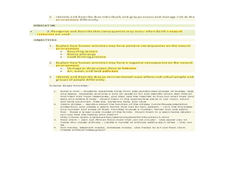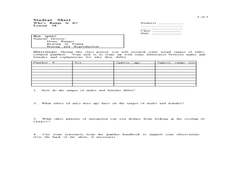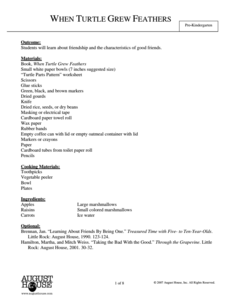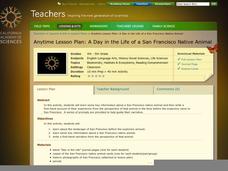Curated OER
Diving the Deep
Children research plant and animal components of marine ecosystem, visualize undersea life, and picture themselves wearing scuba-diving equipment needed to explore underwater. Students then create underwater scene in which they explore...
Curated OER
Fragile Reefs
Students research how coral reefs form, where they are located, and what plant and animal species find shelter in reefs, build and display diorama to represent coral and animals that live in coral reef, and participate in discussion...
Curated OER
Let Me Out! Dino Eggs
Students conduct research about animals that lay eggs such as reptiles and birds. After identifying characteristics of reptiles and discussing the connection to dinosaurs, they create a three-dimensional paper mache dinosaur egg with a...
Curated OER
X-Ray Eyes
Students observe Australian X-ray paintings for information and to understand the art techniques used. Then they imagine and draw the inner organs of an animal. Students also research the anatomy of the animal to analyze the accuracy of...
Curated OER
A Symbol of Protection
Young art critics consider symbolic protection as it has been used in various cultures around the globe. They view body art from the Marquesas Islands, looking for animals, letter, shapes, and patterns. They compare and contrast body art...
Curated OER
Exploring Arizona's Biotic Communities Lesson 1: Mapping Biotic Communities
As part of a unit on Arizona's biotic communities, young ecology learners create a map. They describe how humans and animals adapt in their habitat. They take notes and create graphic organizers from articles they read. Beautiful maps,...
Curated OER
African Ecology and Art
Explore Samburu culture as learners examine art work by many artists and compare and contrast their styles. They view Kenyan images and find Kenya on the map. Students identify conflict in the animal world and draw animals and record in...
Curated OER
Who's Range is it?
Students investigate the habits of panthers by analyzing radio transmitted data. In this animal life lesson, students utilize computers to view the range of different statistics dealing with Florida panthers. Students complete a...
Curated OER
Build A Borneo Glider!
Students construct a paper glider. In this physics of gliding lesson, students first learn about Borneo and it's rainforest habitat. After students discover the way animals in Borneo glide from tree to tree, they use their newly acquired...
Curated OER
Identifying Information in Nonfiction
Second graders investigate information in non-fiction texts. They review the features of a non-fiction text and read the book Nature's Food Chains: What Polar Animals Eat. Pupils discuss the text features and write down one fact they...
Curated OER
Growing Penguins
A collection of photos and accompanying descriptions describing the life cycle of an Adelie penguin is the highlight of this resource. Working in groups, polar explorers match the descriptions to the pictures and create a timeline. An...
Curated OER
Chinese Jeopardy
Play Jeopardy with this primary level China PowerPoint. The questions are simple and focus on the geography, culture, animals, food, and Inventions of China. There are 5 point levels available for each category.
Curated OER
Readings in Hudson River Natural History
Reading and understanding informational text is a key element to understanding every discipline. Elementary learners read three different articles focused on various animals and habitats in the Hudson River. They answer comprehension...
Curated OER
Bats
Use Stellaluna by Janell Canon to discuss bats and other types of animals. Learners identify the differences between bats and birds, list the traits of mammals, create a Bat Facts game, and go on a written scavenger hunt. Fun, clever ideas!
National Wildlife Federation
Massive Migrations: Grades K-8
Migratory animals follow the same path every year. Learners research the path of an assigned species and create a map highlighting key landmarks along the way. As a group, they come up with a presentation to share with their class.
National Wildlife Federation
Brown Pelicans
Even animals that are part of the same species have differences. Learners read a passage about white and brown pelicans and compare their features. They recognize that although the birds look very similar, they also have their own unique...
August House
When Turtle Grew Feathers
Friendship is a valuable part of growing up. Learn about the importance of friendship with a variety of activities based on When Turtle Grew Feathers by Tim Tingle. Kids practice making musical instruments, discussing plot points,...
World Wildlife Fund
Bar Charts & Pie Charts
Learn about life in the Arctic while practicing how to graph and interpret data with this interdisciplinary lesson. Starting with a whole group data-gathering exercise, students are then given a worksheet on which they analyze and create...
World Wildlife Fund
Land of the Midnight Sun
From days of 24 hour sunlight, to endless nights that last for days, the Arctic is a very unique place to live. Examine the seasonal changes that occur in the northern-most reaches of the globe and the impact they have on the plants and...
ARKive
Natural Selection- the Peppered Moth
Can human activity cause animals to evolve? Your budding biologists will find out the answer to some of the big questions in natural selection with a peppered moth activity. They will watch a few short videos, look at pictures, and...
Endangered Species Coalition
Endangered Species Day Art
Albrecht Durer created a highly textured stamp or print of a rhinoceros. To better understand which animals are near extinction, upper graders create similar prints of endangered animals they've researched. The six-day lesson includes...
California Academy of Science
Poetic Reflections
Poetry is a wonderful way to explore language, express topical understanding, and incite creative thinking. After a trip to the local natural history museum (or zoo), learners write an acrostic or a cinquain poem describing one of their...
California Academy of Science
A Day inthe Life of a San Francisco Native Animal
Although the lesson is specifically about the San Francisco Bay area, it's good enough to be adapted to any local region. Children research what the landscape in San Francisco was like prior to settlement, they consider the types of...
BioEd Online
Center of Gravity
Between the pull of gravity and the push of air pressure, it's a wonder animals can balance or move at all. With a hands-on lesson about the center of gravity, learners discuss their own experiences with the topic, then work with...
Other popular searches
- Farm Animals
- Zoo Animals
- Nocturnal Animals
- Prehistoric Animals
- Arctic Animals
- Jungle Animals
- Plants and Animals
- Desert Animals
- Animals and Their Habitats
- Oviparous Animals
- Classification of Animals
- Winter Animals

























